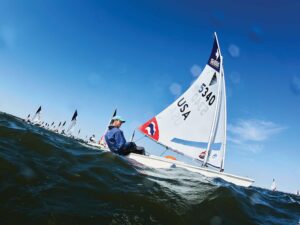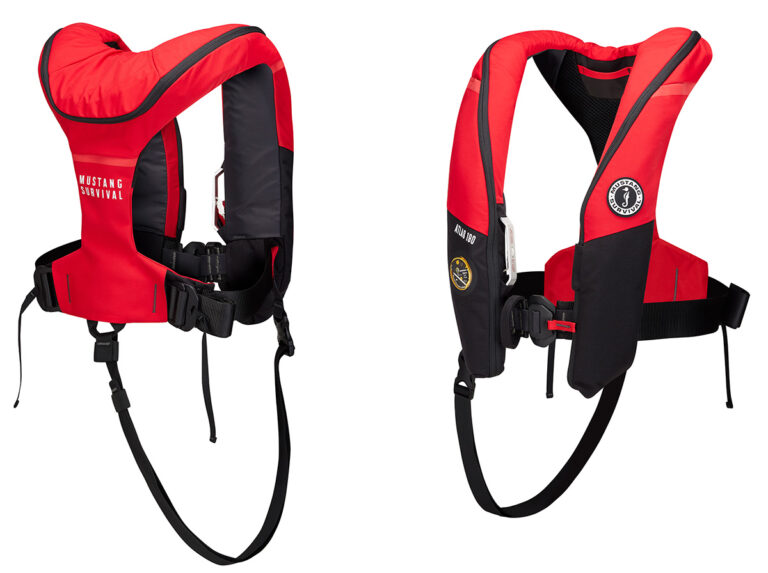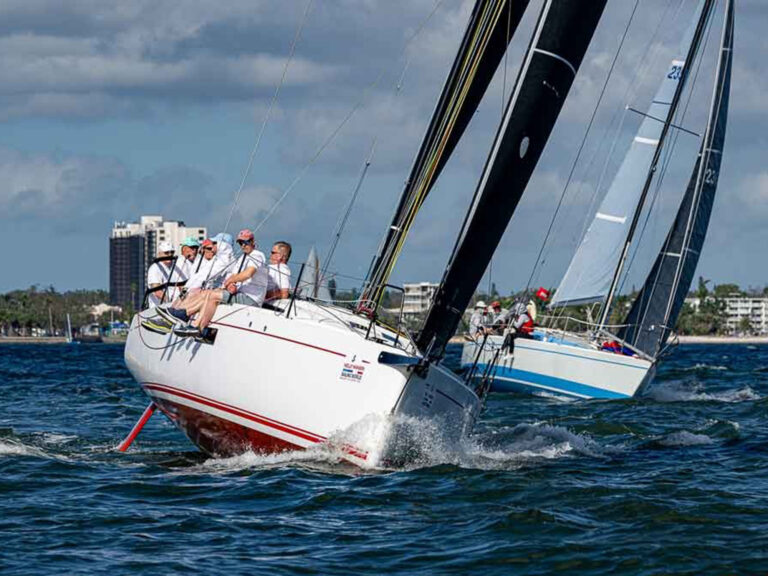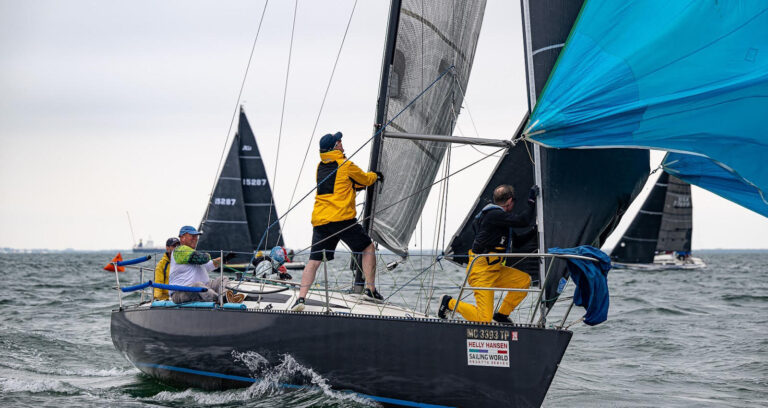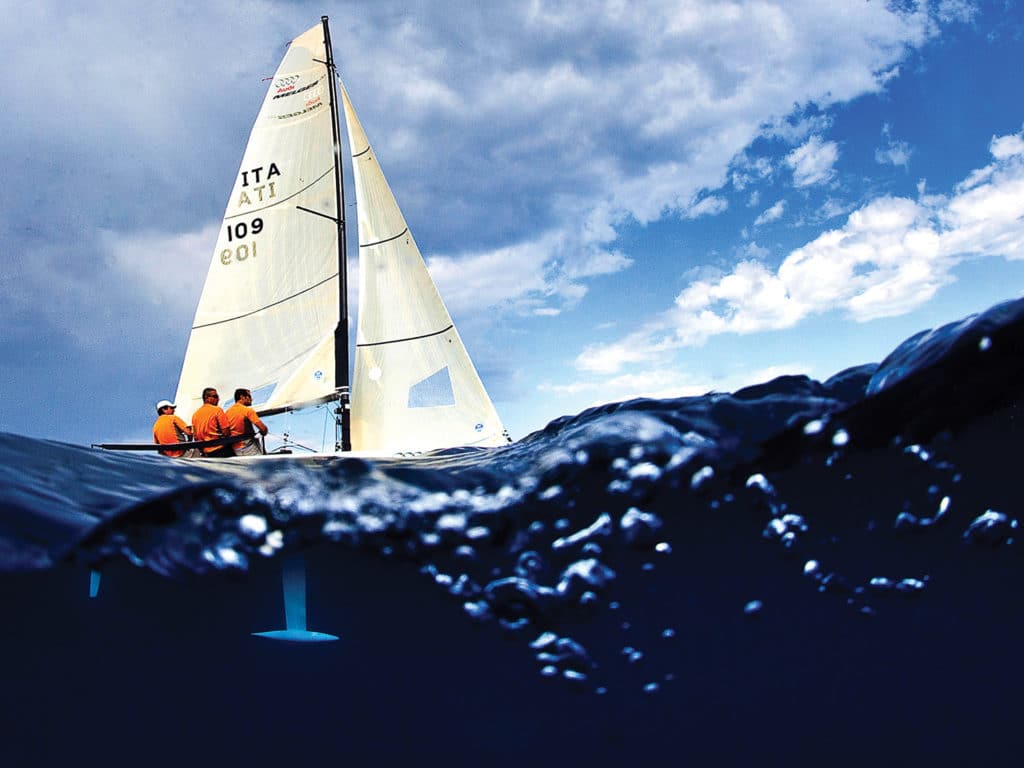
When I first started sailing sportboats more than a decade ago, I was sailing a Melges 24, and our coach, Vince Brun, said, “The big difference between this boat and other keelboats is the skinny keel.” I quickly discovered how right he was. Sportboats love speeding through the water to increase flow over the blades, and when turning, the blades can stall much easier.
Having said that, the difference between sailing a skinny-keel sportboat and a more traditional keelboat, such as an Etchells, is not dramatic; it simply requires tweaking your style. For example, if you want to have a great start in either boat, you line up at a good build angle, hold straight until the boat is full speed and then smoothly carve up to a close-hauled angle just before the start. I try to do this in any sailboat, but if not managed perfectly in a sportboat, there will be a higher price to pay.
How much of a price? That’s difficult to quantify, but as we all know, every little thing matters—and it all adds up. If you want to be at the top of the sportboat fleet, you have to be mindful of the skinny keel and the flow of water over that foil.
Leeward mark roundings embody many of the considerations needed with a skinny-keel boat. In an Etchells, you can be turning as you pass the mark. In fact, you can even luff up a bit, use your momentum and then turn back down without a ton of speed, and you’ll create a beautiful lane. The boat glides, the keel is fat, and you don’t really stall. Do that on a Melges 24, Melges 20, or a J/70, and you’ll go sideways. Onboard, it might not be obvious how much you’re losing, but from a coach boat it is: Boats that do those button-hook turns around the leeward mark get crushed. It’s important to be more calculating and a little farther away from the mark as you approach it—at least as much as the fleet allows.
Brun also recommended sailing past the mark a little bit and have 99 percent of your turn done as you pass the mark. You’ll know you’re doing it right if the tiller is in the middle as you pass the mark. In other words, at the mark, you’re going straight, sailing closehauled. Do that and you’ll have way more grip on your keel and end up in a higher lane than boats still turning as they pass the mark. That’s when the keel stalls and the boat slides sideways.
In a perfect setting—without much traffic and a square course—start your turn when you’re around 2.5 boatlengths abeam of the mark.
It’s OK if your arc takes you a little downwind of the mark before turning up. Again, the idea is that, as you finish the turn and actually pass the mark, you are going straight.
If you’ve done a beautiful mark rounding and you’re going fast in this nice, arcing turn, you can go to final trim about the time you hit closehauled.
If you’re not fast, it could be because the fleet did not allow a beautiful arcing turn, it’s just like the exit of a tack. Trim to about 90 percent until the boat is up to speed. Do this and you’ll have more grip on your keel and incur less leeway. You’ll also end up in a higher lane than boats still turning and maybe overtrimming their sails as they pass the mark.
The tricky thing with your approach to leeward marks is that the wind angle makes a huge difference. If you’re going around a right-hand mark—looking downwind—and are in a big left shift, you don’t have to head up that much because you’re going to be rounding up into the header, which means you’re heading up, but not much because it’s a big left shift. After sailing for a bit, you might tack to get onto the lifted tack. In that case, you can initiate the turn closer to the mark because there’s less turning involved.
You just head up 60 degrees or so and you’re good, so a boatlength away will probably work in these situations. The key is to set up a nice big smooth turn rather than a button-hook.
Making the turn correctly is even more critical in stronger winds because you can get pushed sideways more easily, especially if your sails are overtrimmed when heading up to a closehauled course.
This same negative effect of overtrimming before getting up to speed became apparent to us coming out of tacks when we were first sailing the Melges 24. We were sailing in 12 knots, and right off, we’d pull the traveler up to the normal spot that it rests. The result? We stalled and went sideways out of tacks; the boat heeled too much.
If we divide the traveler position into thirds, the resting spot upwind in 12 knots was a third down from all the way up. So, coming out of a tack, we learned to set it just below the middle. Then we’d hike, chill for a little, let the flow attach to everything, and then pull it up and trim the jib in from its 90 percent position.
RELATED: Inside the Classes: Melges 24
Once up to speed, it’s traveler up and jib in to final trim. This technique was way faster than immediately pulling it up to that third-down spot, which resulted in “flaps down,” too much load on the boat, and lots of sideways sliding. This applies to leeward mark roundings too. If it’s windy and you trim the jib or main in too hard, or traveler up too high as you’re rounding, you go sideways. This happens especially when making a hard turn around the mark. The skipper will sense the boat is sliding and will push the helm even more to compensate. Like every boat, leeward mark roundings require a soft jib and tighter main. Death is trimming all the way in before you’re close-hauled. Again, that’s true in any boat, but more so in a sportboat because the keel is so skinny.
Ducking a boat upwind requires the same considerations. Again, the penalty you pay for turning hard at the boat you’re ducking is greater in a sportboat than a fat-keeled boat, for the same reasons.
You’ll gain more by bearing away early, building speed, and doing a small head-up as you pass astern of the boat you’re ducking.
Similarly, at starts, it’s more important to hold straight and have flow while you’re accelerating. With a fatter keel you can be a little less precise and get away with it, but with a sportboat, it’s all about having speed, not turning too hard, and not overtrimming your sails. All those errors seem to hurt a little more.
If you end up with a boat to leeward of you seemingly too close, still try to go straight while accelerating slightly lower than their angle, to gain grip on your keel. Even though you’re getting closer to the leeward boat, you’ll be generating better speed and grip, which allows you more height and speed once you start the race.
Going fast is the key. Sure, you can overdo it and start reaching around the course, but pinching on a skinny keelboat is far worse.
Many skippers consider that leeward boat a little too close for comfort and push the tiller to leeward while trying to accelerate—tiller toward trouble, which actually stalls the keel and disrupts the acceleration. Understanding what your sportboat needs to generate speed and grip will give you the confidence to close gauge while sailing straight and accelerating. The result is a faster boat that allows you to roll it to leeward and emerge into a sweet lane after the start. Finally, a skinny keel plays a role in how you steer the boat upwind.
If you’re a pincher, your VMG will be worse with a skinny keel because you’re close to stalling all the time, and the boat needs more flow to create lift. You can’t get caught high, pinching for some period of time. You’ll pay the price. Instead, figure out a way to add a couple of tenths to your boatspeed and you will almost always point as high as everyone else because you have way more flow over your blades.
Sometimes, it’s just a matter of pressing on the telltales a fraction and getting the power and heel angle right, often just down a degree from where the inside telltales are dancing. In 10 knots, we might do so and our speed goes from around 5.7 to 5.9, and you think, “OK, we’re clearly sailing a little lower.”
Then you ask the crew on the rail, “How are we pointing?” and they say, “Great, no difference, just going faster!” So, going fast is the key. Sure, you can overdo it and start reaching around the course, but pinching on a skinny keelboat is far worse.
I remember one time on my Etchells when I was bubbling the front of the jib because we were overpowered, and my main trimmer said, “Wow! We’re crushing everyone!” I was like, “Really? Look at the front of the jib. We’ve got 3 inches of backwind, let’s try dropping traveler and sailing more to the telltales.” We put the bow down a bit, got rid of the backwind, and just sagged into people around us for a loss. So, we went back to the higher and slower mode for a gain. That never happens on a sportboat. The skinny keel wants you to go fast, not only upwind, but every time you maneuver the boat.

